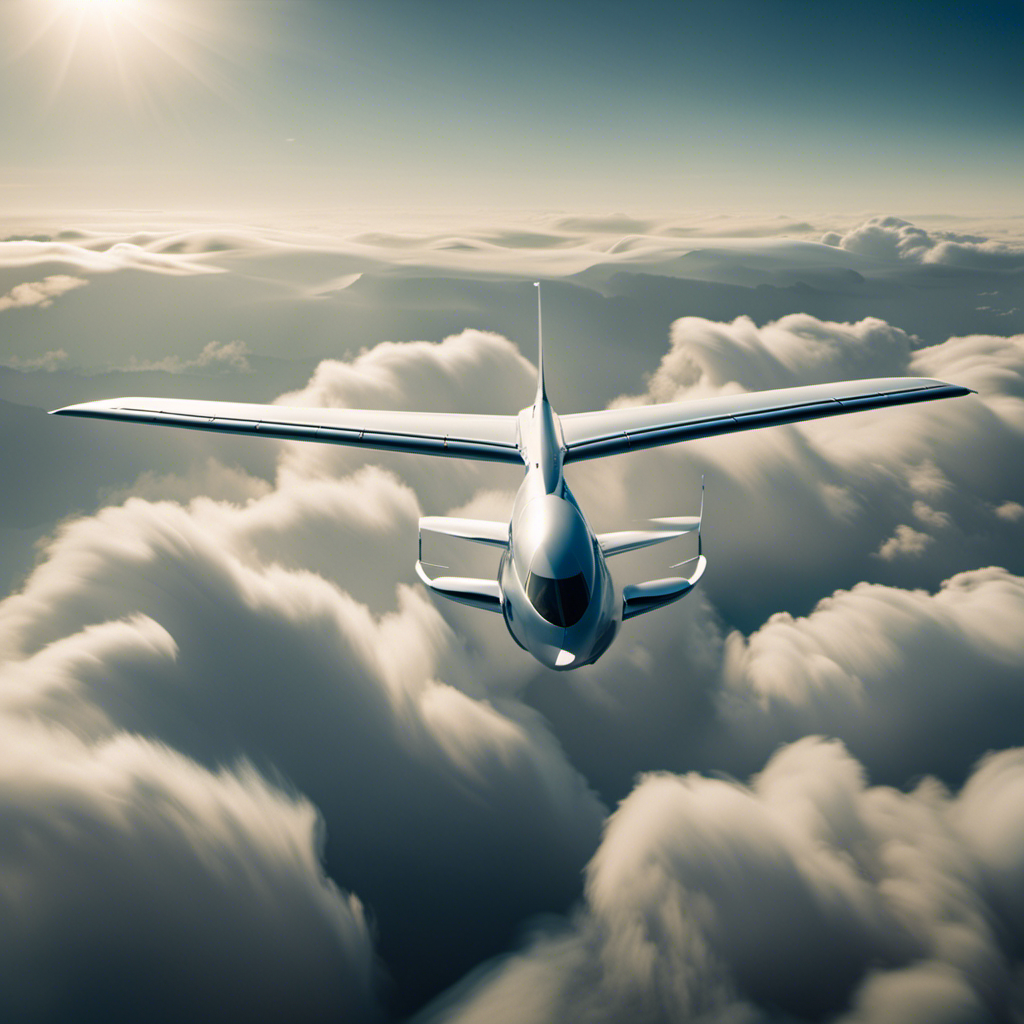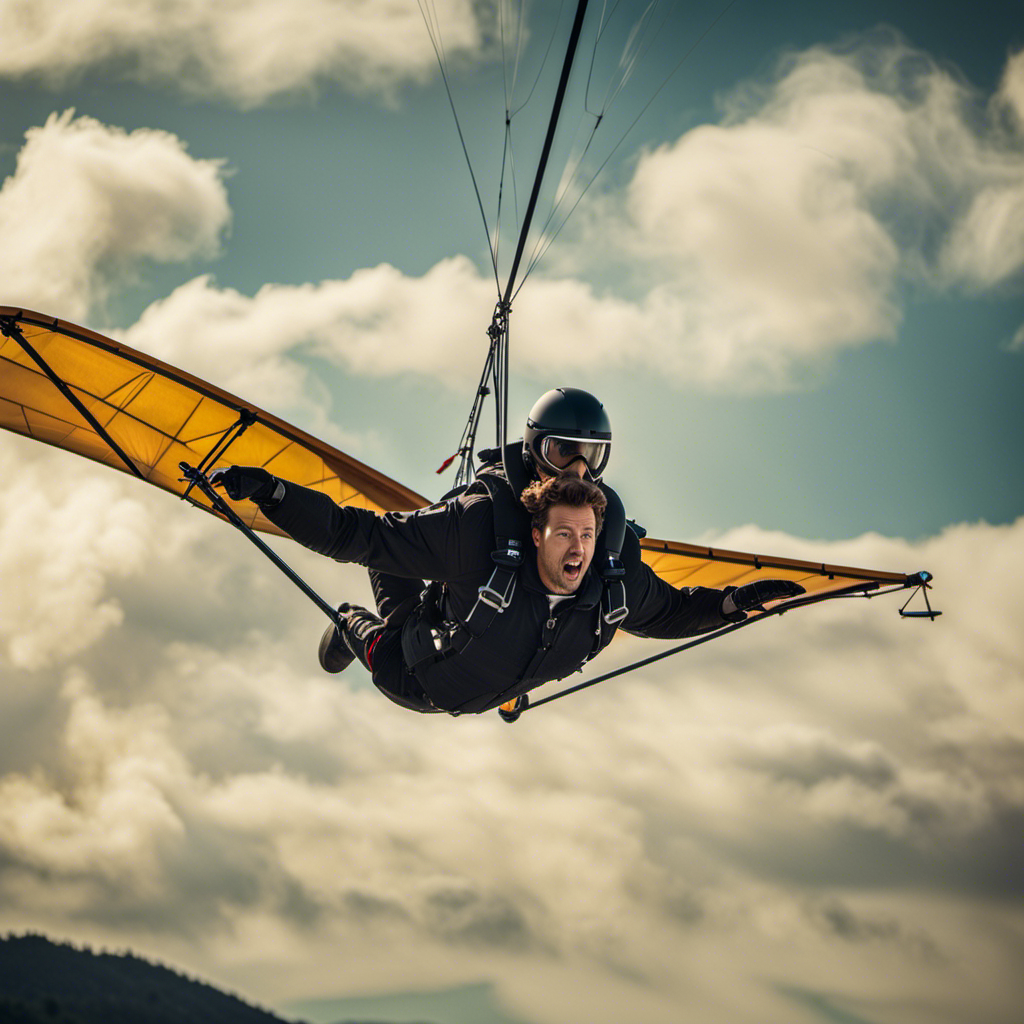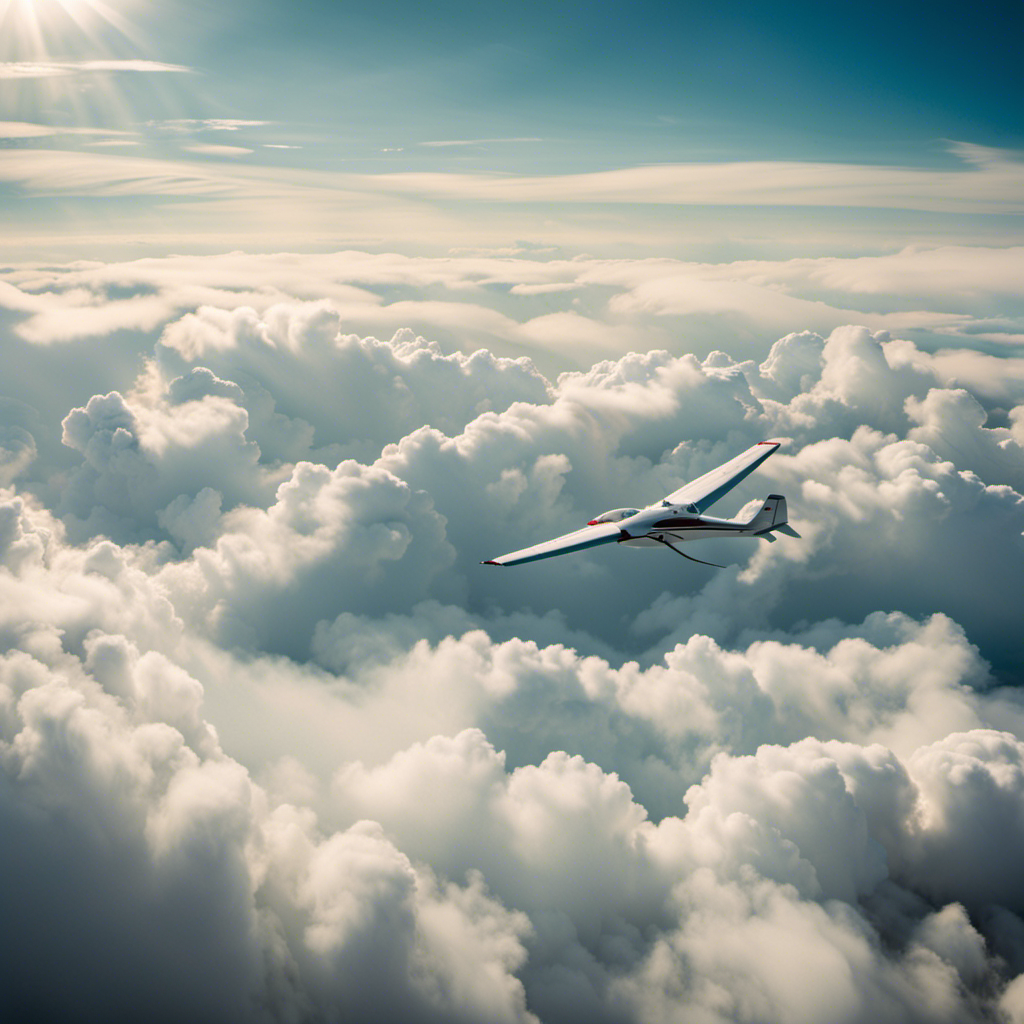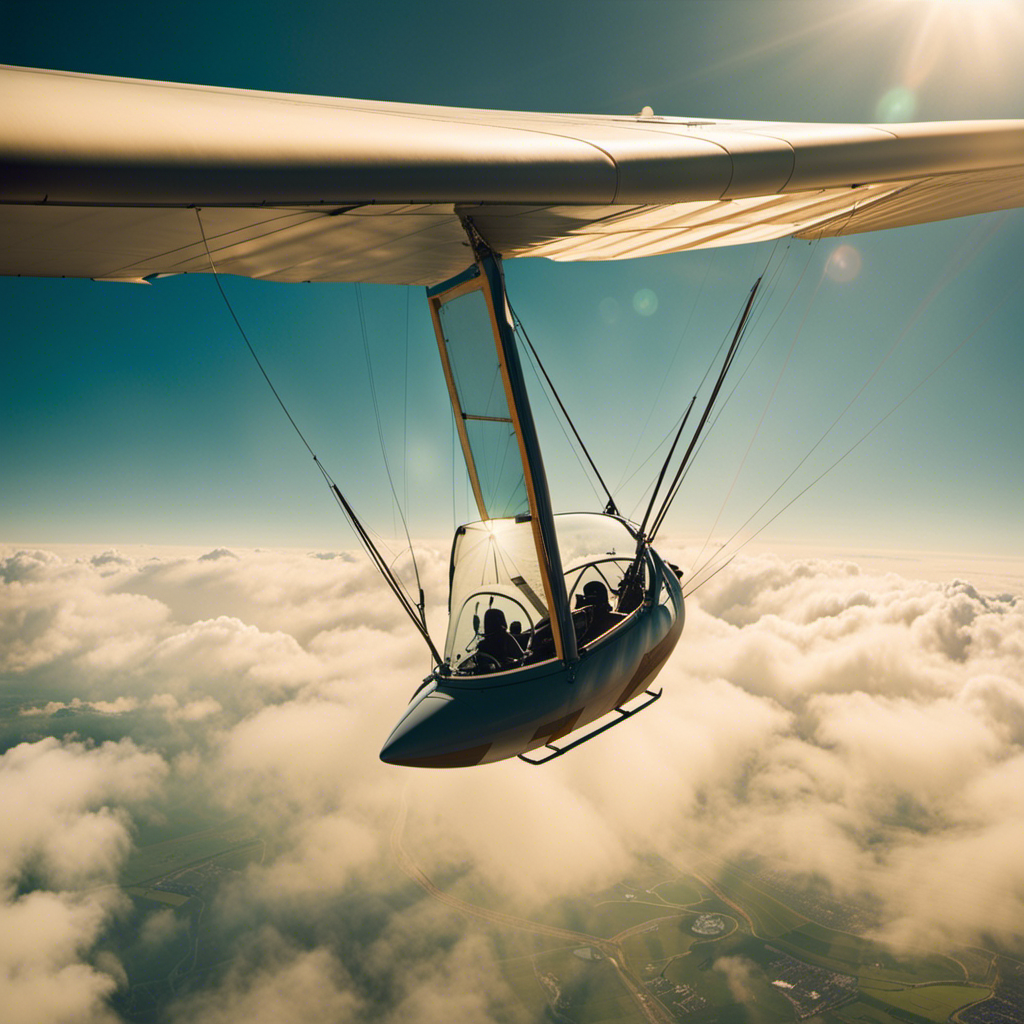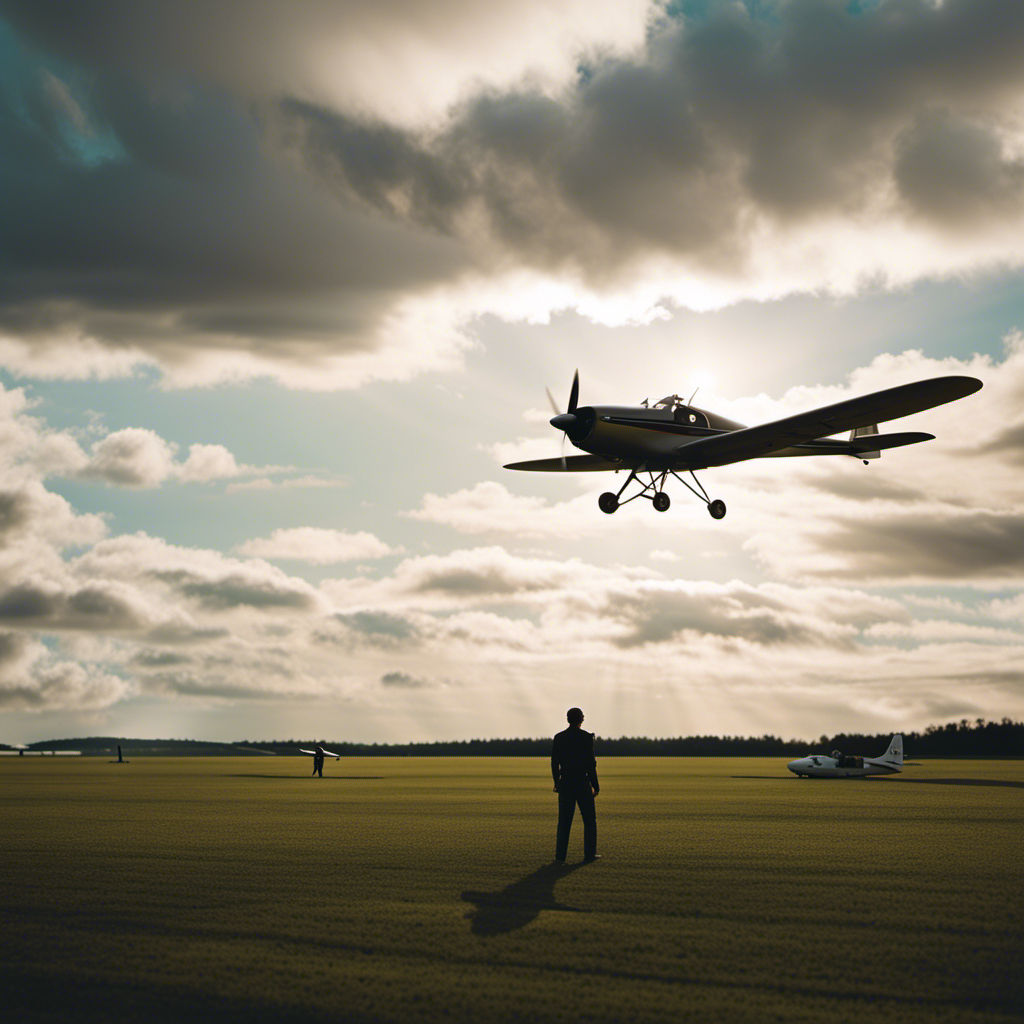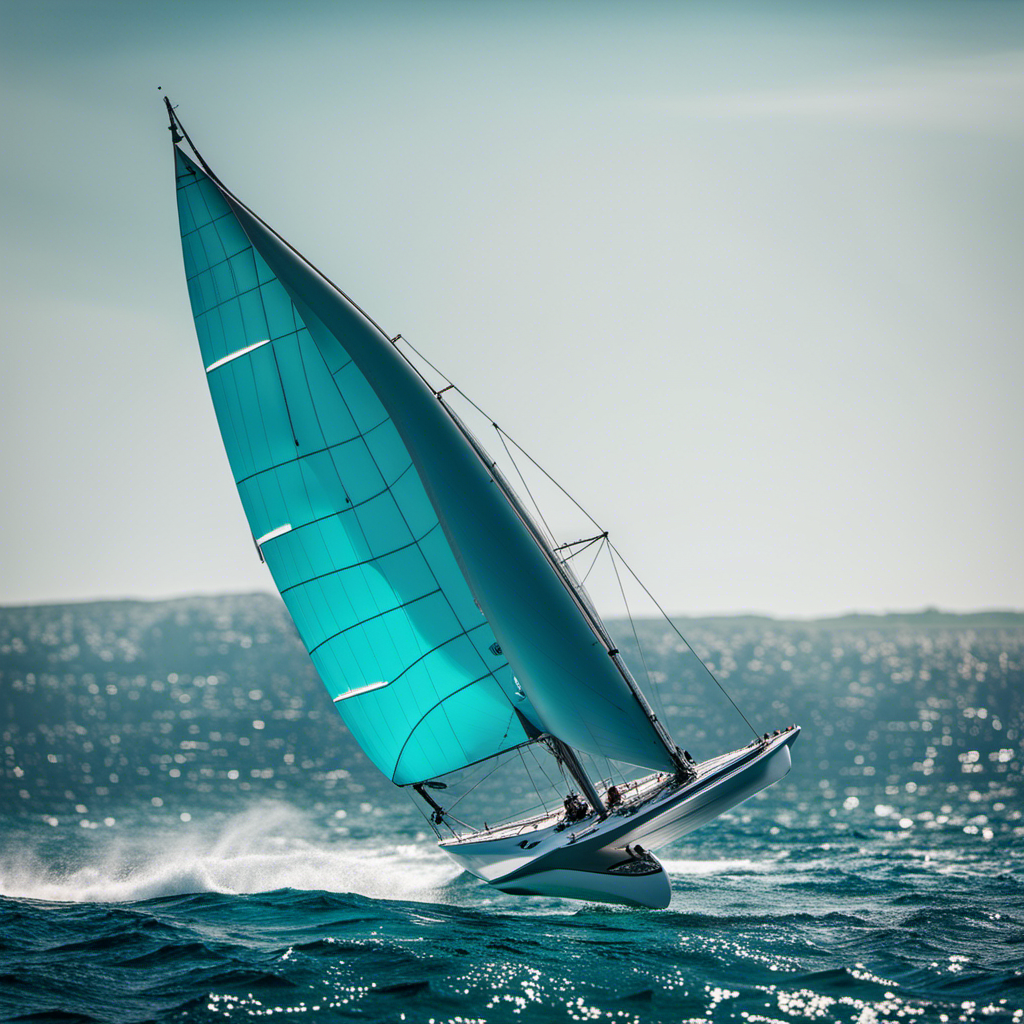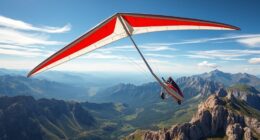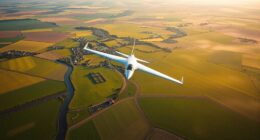As a glider pilot, I was amazed to discover that the top speed of a glider plane can reach an impressive 180 miles per hour.
Glider planes, without an engine of their own, rely on the power of nature to soar through the skies.
In this article, we will delve into the factors that influence glider speed, the importance of design and aerodynamics, and the strategies that glider pilots employ to maximize their speed.
Join me on this exhilarating journey as we explore the world of flying at top speed in a glider.
Key Takeaways
- Glider planes can reach speeds of up to 180 miles per hour.
- Factors such as air density, wing design, and angle of attack influence glider speed.
- Nature plays a crucial role in determining glider flight path and duration.
- The world record for glider speed is an impressive achievement, with notable records being 302.9 mph and a 1,544.63-mile flight.
Understanding Glider Planes and How They Fly
Glider planes don’t have engines, so they rely on air currents and thermals for lift and propulsion. To understand the physics of glider flight, it’s important to grasp the concepts of lift and drag.
Lift is the force that opposes weight and keeps the glider airborne. It is generated by the shape of the wings and the air flowing over them. As the glider moves through the air, the wing design creates a pressure difference, with lower pressure on top and higher pressure on the bottom. This pressure difference generates lift, allowing the glider to stay aloft.
Drag, on the other hand, is the resistance encountered by the glider as it moves through the air. It is caused by the friction between the glider and the air molecules. The shape of the glider, including its wings, fuselage, and other components, affects the amount of drag experienced. Minimizing drag is crucial for maximizing the glider’s efficiency and achieving longer flights.
Understanding lift and drag is essential for piloting a glider effectively. By exploiting air currents and thermals, glider pilots can gain altitude and maintain speed. This brings us to the role of nature in glider flight, where we will explore how air currents and thermals contribute to the performance of glider planes.
The Role of Nature in Glider Flight
When flying in a glider, you’ll notice how nature plays a crucial role in determining your flight path and duration. The role of thermals and the influence of wind patterns are two key factors in glider flight. Thermals are columns of rising warm air that can provide lift for gliders. They occur when the sun heats the ground, causing the air above it to rise. As a glider pilot, I rely on thermals to gain altitude and stay aloft. By circling within a thermal, I can harness its upward motion and climb higher. This allows me to extend my flight and explore new areas. The table below illustrates how thermals and wind patterns affect glider flight:
| Nature Factor | Effect on Glider Flight |
|---|---|
| Thermals | Provide lift |
| Wind patterns | Influence direction |
Thermals and wind patterns work together to shape the course of a glider. Wind patterns can push the glider in a certain direction or help it maintain a steady path. By understanding these natural elements, I can plan my flight accordingly and make the most of the available lift. With the knowledge of how thermals and wind patterns impact glider flight, we can now explore the factors that influence glider speed.
Factors That Influence Glider Speed
To maximize your flight speed, it’s important to consider various factors such as air density, wing design, and the angle of attack. These factors play a crucial role in determining how fast a glider can travel through the air.
Air Density:
- High air density increases drag, making it harder for the glider to maintain high speeds.
- Low air density reduces drag, allowing the glider to achieve faster speeds.
Wing Design:
- The shape and size of the wings influence the glider’s speed.
- Wings with a high aspect ratio (long and narrow) reduce drag and increase efficiency, enabling the glider to reach higher speeds.
- The presence of winglets at the wingtips can also improve aerodynamic performance, further enhancing speed.
Angle of Attack:
- The angle at which the wings meet the oncoming airflow affects the lift and drag forces acting on the glider.
- Finding the optimal angle of attack minimizes drag and maximizes lift, resulting in higher speeds.
Considering these factors, glider pilots can make adjustments to optimize their flight speed and performance. However, the importance of design and aerodynamics goes beyond just speed. It also influences the glider’s stability, maneuverability, and overall efficiency. By understanding the principles of design and aerodynamics, pilots can make informed decisions that enhance their flying experience.
The Importance of Design and Aerodynamics
When it comes to designing gliders, two key factors to consider are streamlined shapes and wing configuration. Streamlined shapes help minimize drag, allowing the glider to achieve higher speeds and better efficiency.
Wing configuration, on the other hand, affects the glider’s stability and maneuverability, influencing its overall performance in the air.
Another important aspect is the wing loading and lift-to-drag ratio, which determine how much weight the wings can support and how efficiently the glider can generate lift. These factors play a crucial role in determining the speed and performance of a glider.
Streamlined Shapes and Wing Configuration
The streamlined shape and wing configuration of a glider plane allow it to reach high speeds. The streamlined design reduces drag, allowing the glider to slice through the air with minimal resistance. The efficient wing structure generates lift, enabling the glider to stay airborne and maintain its speed.
Here are some reasons why these features evoke a sense of awe and excitement:
- Increased speed: The streamlined shape reduces air resistance, allowing the glider to achieve impressive velocities.
- Smooth flight: The sleek design minimizes turbulence, creating a stable and enjoyable flying experience.
- Graceful maneuvers: The optimized wing structure enables the glider to perform elegant turns and precise maneuvers in the sky.
- Thrilling sensations: The combination of speed and maneuverability evokes a thrilling sense of freedom and adventure.
Now, let’s explore how wing loading and lift-to-drag ratio further contribute to the performance of a glider plane.
Wing Loading and Lift-to-Drag Ratio
Wing loading and lift-to-drag ratio greatly impact the performance of a glider.
Wing loading refers to the weight of the glider divided by the area of its wings. A higher wing loading means more weight per unit area, which can result in faster glider speeds. However, a high wing loading also means a higher stall speed and reduced maneuverability.
On the other hand, a low wing loading allows for slower speeds and better maneuverability, but may sacrifice speed and performance.
The lift-to-drag ratio, on the other hand, measures the efficiency of a glider’s wings in generating lift versus the drag it creates. A higher lift-to-drag ratio means less drag and therefore a more efficient glider.
These factors are crucial in determining the overall glider performance.
Now, let’s delve into the world record for glider speed.
The World Record for Glider Speed
Although it’s not widely known, the world record for glider speed is an impressive achievement. Gliders are usually associated with slow and graceful flight, but there have been remarkable attempts to push the boundaries of speed in this aircraft category. Technological advancements have played a crucial role in these world record attempts, allowing gliders to achieve incredible speeds.
Here are three notable world record achievements in glider speed:
-
Speed Record: The current world record for glider speed is held by Klaus Ohlmann, who reached a speed of 302.9 miles per hour (487.6 kilometers per hour) in 2003. This extraordinary feat showcases the potential of gliders to reach remarkable velocities.
-
Distance Record: In 2008, Sebastian Kawa set a record for the longest glider flight in terms of distance, covering an astonishing 1,544.63 miles (2,484.99 kilometers). This achievement demonstrates the endurance and efficiency of gliders in maintaining high speeds over long distances.
-
Altitude Record: Steve Fossett holds the record for the highest altitude reached in a glider, soaring to an astonishing height of 50,671 feet (15,445 meters) in 2006. This record highlights the impressive climb capabilities of gliders and their ability to reach extreme heights.
With these remarkable world record achievements, it is evident that gliders have the potential to achieve impressive speeds.
Now, let’s delve into the different types of glider planes and their speed capabilities.
Different Types of Glider Planes and Their Speed Capabilities
After discussing the world record for glider speed, let’s now delve into the different types of glider planes and their speed capabilities. Glider planes come in various models, each designed to excel in different aspects of flight. Some models prioritize speed, while others prioritize maneuverability or endurance. The speed limits of glider planes vary depending on their design and purpose.
For example, the high-performance racing gliders, such as the Schempp-Hirth Ventus 2 and the Alexander Schleicher ASG 29, are built to reach impressive speeds. These sleek and aerodynamic machines can easily surpass 150 knots, or approximately 173 miles per hour. Their sophisticated designs reduce drag and maximize lift, allowing them to cut through the air with minimal resistance.
On the other hand, gliders designed for training or leisurely soaring flights have lower speed limits. These models, like the Schleicher ASK 21 or the Grob G 103 Twin Astir, usually have a maximum speed of around 100 knots, or about 115 miles per hour. Although they may not reach the same speeds as racing gliders, they still provide an enjoyable and exhilarating flight experience.
Now that we understand the different glider plane models and their speed limits, let’s explore how glider pilots maximize speed without compromising safety.
How Glider Pilots Maximize Speed
When it comes to maximizing speed in glider flying, there are three key techniques that I employ.
Firstly, I utilize speed-to-fly techniques. This involves calculating the optimal speed for a given flight condition, taking into account factors such as wind speed and direction.
Secondly, I focus on managing energy. This means efficiently using the available energy sources, such as thermals and ridge lift, to maintain and increase speed.
Lastly, I prioritize optimizing glide ratios. This involves finding the most aerodynamically efficient path to cover the maximum distance with the least amount of altitude loss.
Utilizing Speed-to-Fly Techniques
To maximize your glider’s performance, you’ll want to utilize speed-to-fly techniques. By understanding how to optimize your glide performance, you can effectively navigate thermals and maintain a higher average speed throughout your flight.
One technique often used is the MacCready theory, which helps pilots determine the optimum speed to fly based on the strength of the thermals they encounter. By adjusting their speed accordingly, pilots can minimize energy loss and maximize their overall distance traveled.
Another important aspect of speed-to-fly techniques is the use of ballast. By adding weight to the glider, pilots can increase their sink rate and maintain a higher average speed.
These techniques are crucial in managing energy and glide ratios, allowing pilots to make the most efficient use of their glider’s capabilities.
Moving on to managing energy and glide ratios…
Managing Energy and Glide Ratios
You can effectively manage your energy and glide ratios by adjusting your speed according to the strength of the thermals you encounter. When managing thermals and optimizing airspeed in a glider plane, keep the following in mind:
-
Assess the strength of the thermal: By observing the rate of climb and the size of the thermal, you can determine its strength and adjust your airspeed accordingly.
-
Adjust your speed for maximum climb: When encountering a strong thermal, increase your airspeed to maximize your climb rate and gain altitude efficiently.
-
Slow down in weaker thermals: In weaker thermals, reduce your airspeed to allow for a tighter turn radius, enabling you to stay within the thermal and maximize your climb.
By actively managing your airspeed based on the strength of the thermals, you can optimize your energy and glide ratios for a more efficient flight.
Transitioning into the subsequent section on safety considerations at high speeds, it is important to understand the potential challenges and precautions necessary to maintain a safe flying experience.
Safety Considerations at High Speeds
For increased safety at high speeds, it’s important to be aware of potential aerodynamic limitations in a glider plane. Gliders are designed to fly efficiently and gracefully through the air, but they have speed limitations that must be respected.
The main concern when it comes to speed in a glider is the structural integrity of the aircraft. As the speed increases, the forces acting on the wings and other components also increase, which can lead to structural failure if not properly managed. To ensure safety, it is crucial to adhere to the manufacturer’s speed limitations and follow recommended safety measures.
These measures may include avoiding turbulent or gusty conditions, maintaining appropriate airspeeds, and avoiding abrupt control inputs. Additionally, pilots should be aware of the effects of speed on the glider’s performance, such as increased sink rates and decreased glide ratios.
Understanding these limitations and taking appropriate precautions will help to enhance safety during high-speed flights.
Moving on to the next section, let’s discuss the advantages and limitations of glider speed.
Advantages and Limitations of Glider Speed
Understanding the advantages and limitations of glider speed is crucial for maximizing performance and ensuring safety. While gliders may not reach the same speeds as powered aircraft, they have their own unique benefits and constraints.
One limitation of glider speed is their inability to maintain high velocities for extended periods. Gliders rely on rising air currents, known as thermals, to stay aloft. These thermals are not always present, and when they are, they can be unpredictable. Therefore, gliders must constantly search for these thermals to maintain their speed and altitude.
Another limitation is the impact of weather on glider speed. Strong winds, turbulence, and adverse weather conditions can significantly affect a glider’s ability to maintain a high speed. It is important for glider pilots to closely monitor weather forecasts and make informed decisions based on the current conditions. By understanding these limitations, pilots can make adjustments to their flight plans and take appropriate safety measures.
Now, let’s explore the thrill of flying at top speed in a glider.
The Thrill of Flying at Top Speed in a Glider
Experience the exhilarating rush of soaring through the air in a glider, feeling the wind in your hair and the sense of freedom in each moment. Gliding at top speed is an adrenaline rush like no other. As a glider pilot, I have had the privilege of pushing the limits and experiencing the thrill of speed in the sky.
Glider planes are not known for their speed records, as they rely solely on the natural forces of the air to stay aloft. However, that doesn’t mean they can’t reach impressive speeds. The top speed of a glider depends on various factors, including the design of the aircraft and the weather conditions. On average, a high-performance glider can reach speeds of up to 180 miles per hour (290 kilometers per hour). This may not seem fast compared to powered aircraft, but when you’re flying without an engine, it feels incredibly fast.
To give you a better understanding of the speed capabilities of gliders, here is a table comparing the top speeds of different types of aircraft:
| Aircraft Type | Top Speed (mph) |
|---|---|
| Glider | 180 |
| Commercial Jet | 600 |
| Fighter Jet | 1,500 |
As you can see, gliders may not break speed records, but they still provide an exhilarating experience. Flying at top speed in a glider is a unique sensation that combines the thrill of speed with the serenity of gliding through the air. So, if you’re looking for an adrenaline rush and a sense of freedom unlike any other, try soaring through the sky in a glider.
Frequently Asked Questions
Can a glider plane fly faster than a powered aircraft?
Yes, a glider plane cannot fly faster than a powered aircraft due to its limitations. Glider planes rely solely on air currents for propulsion, while powered aircraft have engines that enable them to achieve higher speeds.
How do glider pilots navigate and control their speed during a flight?
Glider pilots use various techniques to navigate and control their speed during a flight. These include adjusting the angle of attack, using thermals for lift, and employing airbrakes or spoilers to reduce speed.
What are the safety precautions taken by glider pilots when flying at high speeds?
When flying at high speeds, glider pilots ensure safety by using appropriate safety equipment and following rigorous training programs. These measures help mitigate risks and ensure a safe flying experience.
Are there any limitations or restrictions on the top speed of a glider plane?
There are limitations and restrictions on the top speed of a glider plane. These measures ensure the safety of the aircraft and its occupants. Engineers design the aircraft to withstand certain speeds, preventing structural failure and maintaining control.
How does the weight of the glider and pilot affect its maximum speed?
The weight of a glider and pilot significantly affects its maximum speed. A heavier glider will have a lower top speed due to increased drag. Additionally, altitude and wind conditions can also impact glider performance.
Conclusion
And that, my friends, is the exhilarating world of glider planes and their top speeds.
Soaring through the skies with the grace of a bird, gliders defy gravity and push the boundaries of speed.
From the influence of nature to the meticulous design and aerodynamics, every aspect plays a crucial role in achieving maximum velocity.
While safety is of utmost importance, the thrill of flying at top speed in a glider is an experience that cannot be put into words.
So next time you gaze at the sky, remember the incredible feats these majestic aircraft can accomplish.
